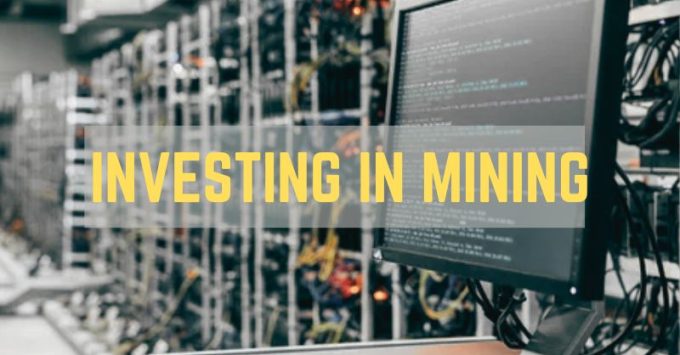Crypto mining involves validating transactions and adding them to a blockchain. Investing in mining is potentially beneficial, but it’s also risky and complex. It’s essential for investors to thoroughly research and consider the many factors that affect the profitability and viability of mining operations. Bitcoin mining is the most widely recognized example of cryptocurrency mining.
Understanding Mining
Miners verify the legitimacy of transactions. This process prevents issues like double-spending where someone tries to spend the same digital currency twice. Transactions are bundled in a block once they are verified. This block is then added to the blockchain, a public ledger of all transactions. By performing mining activities, miners contribute to the security and robustness of the blockchain. The more miners participate, the more secure the network.
Mining involves solving cryptographic puzzles using computer power. These puzzles require a lot of computational effort and are designed to regulate the creation of new blocks. This is the algorithm used by networks like Bitcoin. Miners compete to solve a difficult problem first. The first miner to solve it gets the right to add a new block to the blockchain. Some cryptocurrencies use different mechanisms, like Proof of Stake (PoS), which is less energy-intensive and doesn’t require powerful hardware.
Initially, mining is done with regular Central Processing Units (CPUs). However, this is no longer viable for most cryptocurrencies due to increased difficulty levels. Graphics Processing Units are more powerful than CPUs and are commonly used in mining rigs for their ability to perform complex calculations more efficiently. Application-Specific Integrated Circuits are custom-built for mining specific cryptocurrencies. They are much faster and more efficient than GPUs but are also more expensive.
Investing in Mining
Investing in mining is an effective way to invest in crypto. It involves several key aspects:
Initial Investment
Mining requires significant upfront investment in hardware. This includes powerful computers, often with high-end graphics processing units (GPUs) or specialized hardware known as ASICs (Application-Specific Integrated Circuits), designed specifically for mining.
Electricity Costs
Mining consumes a considerable amount of electricity. The profitability of mining depends heavily on the cost of electricity in your location.
Technical Knowledge
Setting up and maintaining mining equipment requires a degree of technical knowledge. Miners need to optimize their hardware, maintain a stable internet connection, and troubleshoot any issues that arise.
Mining Pools
Due to the competitive nature of mining, individual miners often join mining pools, where they combine their computational power with others to increase their chances of earning rewards. Rewards are then split among pool members according to their contributed mining power.
Market Volatility
The value of cryptocurrencies is highly volatile. This affects the profitability of mining, as the rewards are in the form of digital currencies whose value fluctuates widely.
Environmental Considerations
Cryptocurrency mining has a significant environmental impact, mainly due to its high energy consumption. This aspect is increasingly coming under notice and potential miners should consider the environmental implications of their activities.

How to Invest in Mining?
Investing in cryptocurrency mining requires careful planning, an understanding of the cryptocurrency market, and a willingness to invest in the necessary equipment and resources. Here’s a step-by-step guide on how to start investing in mining:
-
Research and Education
Learn how cryptocurrency mining works, the different algorithms used (like Proof of Work and Proof of Stake), and the specific requirements for mining various cryptocurrencies. Keep up with the latest trends and changes in the cryptocurrency market as they significantly impact the profitability of mining.
-
Choose a Cryptocurrency to Mine
Evaluate which cryptocurrencies are most profitable to mine. This depends on factors like the current price of the cryptocurrency, block reward, and total network mining power. Different cryptocurrencies use different mining algorithms. Make sure that your chosen cryptocurrency is compatible with your planned mining setup.
-
Invest in Mining Hardware
Decide between ASIC (Application-Specific Integrated Circuit) and GPU (Graphics Processing Unit) mining setups. ASICs are more efficient but are also more expensive and limited to mining specific cryptocurrencies. GPUs are more versatile but less powerful. To reduce costs, consider purchasing used mining equipment, but be aware of potential wear and tear.
-
Set Up a Mining Rig
If using GPUs, you’ll need to assemble multiple graphics cards along with a motherboard, power supply, cooling system, and other components. Make sure you have a suitable location for mining. It should be cool and well-ventilated as mining hardware generates heat.
-
Calculate Operational Costs
This is often the most significant recurring cost. Calculate your potential electricity costs against the expected mining rewards for profitability. Reliable internet is crucial. Also, factor in maintenance costs for your hardware.
-
Join a Mining Pool
Join a mining pool where miners combine their computational power to increase the chances of successfully mining a block. Different pools have different fee structures and payout methods. Choose one that aligns with your goals.
-
Set Up a Wallet
Before you start mining, set up a cryptocurrency wallet to store your mining rewards. Make sure it supports the cryptocurrency you plan to mine.
-
Optimize and Monitor Your Mining Rig
Regularly update your mining software and optimize your hardware settings to maximize efficiency. Keep track of your rig’s performance, temperature, and overall health to prevent downtime.

Popular Crypto-Mining Platforms
You can invest in mining through several well-known platforms and services in the cryptocurrency mining sector. These include mining pools, cloud mining services, and specialized software. Some of the notable platforms that are used for investing in mining are:
Slush Pool
Slush Pool, launched in 2010 by Marek Palatinus, is one of the first mining pools in the cryptocurrency world. It’s particularly famous for mining Bitcoin and played a significant role in the early development of the Bitcoin mining ecosystem. Its key features include:
- The pool uses a unique scoring system to calculate rewards to discourage pool-hopping and guarantee fair reward distribution based on contribution.
- Slush Pool is known for its accessible and easy-to-navigate interface.
- It provides detailed real-time statistics about miners’ performance, earnings, and other relevant data.
- Besides Bitcoin, Slush Pool also supports Zcash, a cryptocurrency focused on enhanced privacy.
- Slush Pool enhances security by requiring a second verification form beyond just a password.
BTC.com
BTC.com is a prominent cryptocurrency platform offering a range of services including a mining pool, a wallet service, and a blockchain explorer. It’s known for its comprehensive tools and services for both Bitcoin and Bitcoin Cash mining. Its key aspects include:
- com offers an advanced, professional dashboard that gives miners detailed data about their mining activity, earnings, and pool performance.
- com uses the PPS method for reward distribution which provides a consistent mining payout.
- It implements strong security measures to protect miners’ earnings and data.
- It also provides a mobile app for convenient access to mining data and account management.
CGMiner
CGMiner is a widely-used open-source ASIC/FPGA miner written in C, and it’s available for Windows, Linux, and macOS. It was developed by Con Kolivas and Andrew Smith to be a versatile and high-performance mining software for various cryptocurrencies. Key features include:
- It is compatible with a wide range of ASIC and FPGA hardware.
- CGMiner operates via a command-line interface which offers experienced users detailed control over the mining process.
- CGMiner automatically scales frequency based on error rate.
- It includes options for monitoring the temperature and performance of the mining hardware.
BFGMiner
BFGMiner is another popular open-source mining software, also written in C. ASIC mining hardware users utilize its versatile, modular, and feature-packed environment for cryptocurrency mining. Its key aspects and services include:
- BFGMiner is primarily designed for ASICs and FPGAs.
- It provides options for dynamic clocking, monitoring, and remote operations.
- BFGMiner features a modular architecture that allows users to enable or disable specific devices and features easily.
- It supports a variety of mining pools and algorithms which gives users flexibility during mining.
Bitmain
Bitmain Technologies Ltd. is one of the world’s leading producers of ASIC (Application-Specific Integrated Circuit) hardware used in cryptocurrency mining. Founded in 2013 by Jihan Wu and Micree Zhan, Bitmain has played a significant role in the development and proliferation of specialized mining hardware, particularly for Bitcoin mining. Some of its key features are:
- Bitmain’s Antminers are a preferred choice for large-scale mining operations because they offer high hash rates and energy efficiency.
- It offers a variety of models catering to different levels of miners, from entry-level to professional-grade hardware.
- Bitmain has a substantial global presence, supplying hardware to miners around the world.

